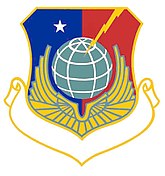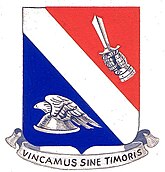323d Expeditionary Operations Group
| 323d Expeditionary Operations Group | |
|---|---|
Distinguished Unit Citation | |
| Insignia | |
| 323d Air Expeditionary Group emblem |  (approved 25 September 1973)[2][note 1] (approved 25 September 1973)[2][note 1] |
| 323d Bombardment Group emblem (Approved 16 February 1943)[3] |  |
| Tail marking (World War II)[1] | Horizontal white band |
The 323d Expeditionary Operations Group is a provisional
During
The group was again active during the 1950s as the 323d Fighter-Bomber Group, flying
History
World War II
 Media related to 323d Bombardment Group (United States Army Air Forces) at Wikimedia Commons
Media related to 323d Bombardment Group (United States Army Air Forces) at Wikimedia Commons

Training in the United States
The unit was first activated in August 1942 at Columbia Army Air Base, South Carolina as the 323d Bombardment Group with the 453d, 454th, 455th and 456th Bombardment Squadron assigned as its original squadrons.[4][5][6][7][8] It trained under Third Air Force in the southeastern United States with Martin B-26 Marauders. The group moved to England beginning in April 1943. The flight echelons few via the southern ferry route except for that of the 456th Squadron, which flew the northern route. The ground echelon sailed on the RMS Queen Elizabeth.[4][9]
Combat in the European Theater
The group arrived at
In June 1943, the group and all other Eighth Air Force B-26 units became part of
Along with other Marauder units of the 3d Wing, the 323d transferred to Ninth Air Force in October 1943, which moved from Egypt to absorb the resources of VIII Air Support Command. The group flew missions against V-1 flying bomb and V-2 rocket sites along the coast of France and attacked airfields at Leeuwarden and Venlo in conjunction with the Allied campaign against the Luftwaffe and aircraft industry during Big Week, from 20 to 25 February 1944.[4]
The 323d helped to prepare for
Between 16 and 26 August, the 323d moved to
As Allied forces advanced into Germany, the group struck
Air Force Reserve

The group was activated in September 1947 in the

Fighter operations
The group was redesignated the 323d Fighter-Bomber Group and activated at
On 15 December 1991, Air Training Command implemented the Objective Wing concept at Mather Air Force Base and the group was reactivated as the 323d Operations Group of the 323d Flying Training Wing. The Base Realignment and Closure directed that Mather close on 30 September 1993. Group squadrons began to inactivate in early 1992 and the group and its remaining squadrons were inactivated on 31 May 1993,[4] and its mission and most of its Boeing T-43 aircraft were reassigned to the 12th Operations Group at Randolph Air Force Base, Texas.[citation needed]
Expeditionary operations
In March 2003, the group was converted to provisional status and renamed the 323d Expeditionary Operations Group. It was assigned to
Lineage
- Constituted as the 323d Bombardment Group (Medium) on 19 June 1942
- Activated on 4 August 1942
- Redesignated 323d Bombardment Group, Medium on 5 August 1944
- Inactivated on 12 December 1945
- Redesignated 323d Bombardment Group, Light
- Activated in the reserve on 9 September 1947
- Ordered to active duty on 10 March 1951
- Inactivated on 17 March 1951
- Redesignated 323d Fighter-Bomber Group on 9 May 1955
- Activated on 8 August 1955
- Inactivated on 1 September 1957
- Redesignated 323d Tactical Fighter Group on 31 July 1985 (not active)
- Redesignated 323d Operations Group
- Activated on 1 September 1991
- Inactivated on 31 May 1993
- Redesignated as 323d Expeditionary Operations Group and converted to provisional status on 25 March 2003[4]
Assignments
- III Bomber Command, 4 August 1942 – 25 April 1943.[16]
- 3d Bombardment Wing (later
- IX Air Force Service Command, 15 June 1945
- United States Air Forces Europe, 25 November – 12 December 1945
- 310th Bombardment Wing (later 310th Air Division), 9 September 1947
- 323d Bombardment Wing, 10 May 1949 – 17 March 1951
- 323d Fighter-Bomber Wing, 8 August 1955 – 1 September 1957
- 323d Flying Training Wing, 15 December 1991 – 1 October 1993[19]
Components
- 323d Operations Support Squadron: 15 December 1991 – 31 May 1993
- 450th Flying Training Squadron: 15 December 1991 – 10 November 1992
- 451st Flying Training Squadron: 15 December 1991 – 15 January 1992
- 452d Flying Training Squadron: 15 December 1991 – 31 May 1993
- 453d Bombardment Squadron (later 453d Fighter-Bomber Squadron, 453d Flying Training Squadron): 4 August 1942 – 12 December 1945; 10 May 1949 – 17 March 1951; 8 August 1955 – 1 September 1957; 15 December 1991 – 31 May 1993
- 454th Bombardment Squadron (later 454th Fighter-Bomber Squadron, 454th Flying Training Squadron): 4 August 1942 – 12 December 1945; 10 May 1949 – 17 March 1951; 8 August 1955 – 1 September 1957; 15 December 1991 – 31 May 1993
- 455th Bombardment Squadron(later 455th Fighter-Bomber Squadron, 455th Flying Training Squadron): 4 August 1942 – 12 December 1945; 10 May 1949 – 17 March 1951; 8 August 1955 – 1 September 1957; 15 December 1991 – 31 May 1993
- 456th Bombardment Squadron: 4 August 1942 – 12 December 1945; 26 September 1947 – 17 March 1951[4]
Stations
- Columbia Army Air Base, South Carolina, 4 August 1942
- MacDill Field, Florida, 21 August 1942
- Myrtle Beach Bombing Range, South Carolina, 2 November 1942 – 25 April 1943
- RAF Horham (AAF-119),[20] England, 1 May 1943
- RAF Earls Colne (AAF-358),[20] England, 14 June 1943
- RAF Beaulieu (AAF-408), England,[20] 21 July 1944
- Lessay Airfield (A-20),[21] France, 26 August 1944
- Chartres Airfield (A-40),[21]France, 21 September 1944
- Laon/Athies Airfield (A-69),[21]France, 13 October 1944
- Denain/Prouvy Airfield (A-83),[21]France, February 1945
- AAF Station Gablingen, Germany, 15 May 1945
- AAF Station Landsberg, Germany, 16 July 1945
- Clastres Airfield, France, October – December 1945
- Camp Myles Standish, 11–12 December 1945
- Tinker Air Force Base, Oklahoma, 27 June 1949 – 28 March 1951
- Bunker Hill Air Force Base, Indiana, 8 August 1955 – 1 September 1957
- Mather Air Force Base, California, 15 December 1991 – 31 May 1993[19]
Aircraft
- Martin B-26 Marauder (1942–1945)
- Douglas B-26 Invader (1949–1951)
- North American F-86 Sabre (1955–1957)
- North American F-100 Super Sabre (1956–1957)
- Boeing T-43 (1991–1993)
- Cessna T-37 Tweet (1991–1993)[4]
Awards and campaigns
| Award streamer | Award | Dates | Notes |
|---|---|---|---|
Distinguished Unit Citation |
24–27 December 1944 | 323d Bombardment Group[4] |
| Campaign Streamer | Campaign | Dates | Notes |
|---|---|---|---|
| Air Offensive, Europe | 1 May 1943 – 5 June 1944 | 323d Bombardment Group[4] | |
| Normandy | 6 June 1944 – 24 July 1944 | 323d Bombardment Group[4] | |
| Northern France | 25 July 1944 – 14 September 1944 | 323d Bombardment Group[4] | |
| Rhineland | 15 September 1944 – 21 March 1945 | 323d Bombardment Group[4] | |
| Ardennes-Alsace | 16 December 1944 – 25 January 1945 | 323d Bombardment Group[4] | |
| Central Europe | 22 March 1944 – 21 May 1945 | 323d Bombardment Group[4] | |
| Air Combat, EAME Theater | 1 May 1943 – 11 May 1945 | 323d Bombardment Group[4] |
See also
- List of Douglas A-26 Invader operators
- List of F-86 Sabre units
- List of F-100 units of the United States Air Force
- List of Martin B-26 Marauder operators
- List of United States Air Force Groups
References
Notes
Citations
- ^ a b Watkins, pp. 101–102
- ^ Ravenstein, p. 174
- ^ Maurer, Combat Units, pp. 203–204
- ^ a b c d e f g h i j k l m n o p q r s t u v Robertson, Patsy (28 May 2010). "Factsheet 323d Expeditionary Operations Group (USAFE)". Air Force Historical Research Agency. Archived from the original on 4 March 2016.
- ^ Maurer, Combat Squadrons, pp. 558–559
- ^ Maurer, Combat Squadrons, pp. 559–560
- ^ Maurer, Combat Squadrons, pp. 560–561
- ^ Maurer, Combat Squadrons, pp. 561–562
- ^ a b c Freeman, p. 249
- ^ a b Freeman, p. 58
- ^ See Mueller, p. 549
- ^ Cantwell, p. 74
- ^ Cantwell, p. 87
- ^ a b Ravenstein, pp. 174–176
- ^ Cantwell, p. 96
- ^ Maurer indicates that the group was assigned to the 3d Bombardment Wing during this period. The 98th Wing was an element of these commands during the relevant period. Maurer, Combat Units, pp. 413–414. Freeman agrees for the period the group was part of Eighth Air Force. Freeman, p. 249. Rust states that all B-26 groups transferred to Ninth Air Force in October 1943 were assigned to the 3d Bombardment Wing. Rust, p. 47.
- ^ Maurer, Combat Units, pp. 413–414; Freeman, p. 249; Rust, p. 47.
- IX Bomber Commandafter 18 February 1944
- ^ a b Lineage and station information in Robertson, AFHRA Factsheet, except as noted
- ^ a b c Station number in Anderson
- ^ a b c d Station number in Johnson
Bibliography
![]() This article incorporates public domain material from the Air Force Historical Research Agency
This article incorporates public domain material from the Air Force Historical Research Agency
- Anderson, Capt. Barry (1985). Army Air Forces Stations: A Guide to the Stations Where U.S. Army Air Forces Personnel Served in the United Kingdom During World War II (PDF). Maxwell AFB, AL: Research Division, USAF Historical Research Center. Archived from the original (PDF) on 4 March 2016. Retrieved 7 July 2012.
- Cantwell, Gerald T. (1997). Citizen Airmen: a History of the Air Force Reserve, 1946–1994. Washington, D.C.: Air Force History and Museums Program. ISBN 0-16049-269-6. Retrieved 1 October 2014.
- ISBN 978-0-87938-638-2.
- Johnson, 1st Lt. David C. (1988). U.S. Army Air Forces Continental Airfields (ETO) D-Day to V-E Day (PDF). Maxwell AFB, AL: Research Division, USAF Historical Research Center. Archived from the original (PDF) on 29 September 2015.
{{cite book}}: CS1 maint: numeric names: authors list (link) - Maurer, Maurer, ed. (1983) [1961]. Air Force Combat Units of World War II (PDF) (reprint ed.). Washington, DC: Office of Air Force History. LCCN 61060979.
- Maurer, Maurer, ed. (1982) [1969]. Combat Squadrons of the Air Force, World War II (PDF) (reprint ed.). Washington, DC: Office of Air Force History. OCLC 72556.
- Mueller, Robert (1989). Air Force Bases, Vol. I, Active Air Force Bases Within the United States of America on 17 September 1982 (PDF). Washington, DC: Office of Air Force History. ISBN 0-912799-53-6.
- Ravenstein, Charles A. (1984). Air Force Combat Wings, Lineage & Honors Histories 1947–1977. Washington, DC: Office of Air Force History. ISBN 0-912799-12-9.
- Rust, Kenn C. (1967). The 9th Air Force in World War II. Fallbrook, CA: Aero Publishers, Inc. LCCN 67-16454.
- Watkins, Robert (2008). Battle Colors. Vol. III Insignia and Markings of the Ninth Air Force in World War II. Atglen, PA: Shiffer Publishing Ltd. ISBN 978-0-7643-2938-8.
Volume IV, European-African-Middle Eastern Theater of Operations
- Further reading
- ISBN 978-0-900913-80-8.
- Freeman, Roger A. (1996) The Ninth Air Force in Colour: UK and the Continent-World War Two. After the Battle ISBN 1-85409-272-3
- Rogers, Brian. (2005). United States Air Force Unit Designations Since 1978. Hinkley, UK: Midland Publications. ISBN 1-85780-197-0.


